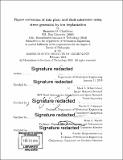| dc.contributor.advisor | Mark L. Schattenburg. | en_US |
| dc.contributor.author | Chalifoux, Brandon D. | en_US |
| dc.contributor.other | Massachusetts Institute of Technology. Department of Mechanical Engineering. | en_US |
| dc.date.accessioned | 2019-07-19T19:34:39Z | |
| dc.date.available | 2019-07-19T19:34:39Z | |
| dc.date.copyright | 2019 | en_US |
| dc.date.issued | 2019 | en_US |
| dc.identifier.uri | https://hdl.handle.net/1721.1/121845 | |
| dc.description | Thesis: Ph. D., Massachusetts Institute of Technology, Department of Mechanical Engineering, 2019 | en_US |
| dc.description | Cataloged from PDF version of thesis. | en_US |
| dc.description | Includes bibliographical references (pages 213-225). | en_US |
| dc.description.abstract | I developed a method to correct height errors in thin substrates. Accurately-figured thin plates and shallow shells are important for large-area space telescopes and for the semiconductor industry. Thin substrates can be bent into the desired shape, for example by tens of microns on a 100 mm diameter substrate, by applying stress to their surface. Ion implantation is one of many possible approaches to applying a controlled stress field to the surface of a substrate. I develop analytical and numerical approaches to calculating stress fields that generate a desired deformation field in thin flat plates and shallow shells. Equibiaxial stress alone is insufficient to generate some deformation fields exactly, making non-equibiaxial stress components critical for figure correction, in general. I experimentally demonstrate the generation of non-equibiaxial stress using ion implantation in glass substrates, by angling the ion beam. To generate a desired deformation field, I developed a process to calculate, and built a system to implement, implantation recipes (i.e. the doses and ion beam angles at each substrate position) on 100 mm glass wafers. Using this system, I demonstrate a 2-4 x improvement in height and slope errors of glass wafers using ion implantation. I also demonstrate the use of ion implantation to compensate for the deformation caused by stress in thin film coatings. Thin films, such as those used for mirror coatings, often have non-uniform equibiaxial stress fields. I developed a process to restore the figure of 100 mm silicon wafers that have been deformed by thin metal films, by applying the same equibiaxial stress field on the other side of the wafer using ion implantation. I demonstrate a 20 x reduction of the coating-induced deformation. | en_US |
| dc.description.statementofresponsibility | by Brandon D. Chalifoux. | en_US |
| dc.format.extent | 225 pages | en_US |
| dc.language.iso | eng | en_US |
| dc.publisher | Massachusetts Institute of Technology | en_US |
| dc.rights | MIT theses are protected by copyright. They may be viewed, downloaded, or printed from this source but further reproduction or distribution in any format is prohibited without written permission. | en_US |
| dc.rights.uri | http://dspace.mit.edu/handle/1721.1/7582 | en_US |
| dc.subject | Mechanical Engineering. | en_US |
| dc.title | Figure correction of thin plate and shell substrates using stress generated by ion implantation | en_US |
| dc.type | Thesis | en_US |
| dc.description.degree | Ph. D. | en_US |
| dc.contributor.department | Massachusetts Institute of Technology. Department of Mechanical Engineering | en_US |
| dc.identifier.oclc | 1102058046 | en_US |
| dc.description.collection | Ph.D. Massachusetts Institute of Technology, Department of Mechanical Engineering | en_US |
| dspace.imported | 2019-07-19T19:34:19Z | en_US |
| mit.thesis.degree | Doctoral | en_US |
| mit.thesis.department | MechE | en_US |
